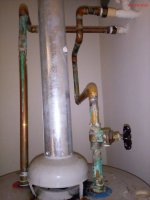chrisoffice
New Member
I am going to replace this 10+ year old water heater, and am thinking about re-do all the pipework that goes into the water heater, as shown on the picture, those copper pipes are covered with greenish corrosion.
The cold water goes from the water main to the water heater directly, the original installer made several turns on the copper pipe before it goes into the heater, to reduce the water pressure maybe?
I am going to use the 18-inch flexible pipe to connect both the hot and cold water to the water heater. Now the question is, because I am getting rid of all those copper pipes shown on the picture, and maybe it is not a good idea to directly connect the new flexible pipes to the remaining outlets in the wall. How should I run the new copper pipes from the wall outlet before it connects to the flexible pipes?
Thanks!
Last edited by a moderator:

